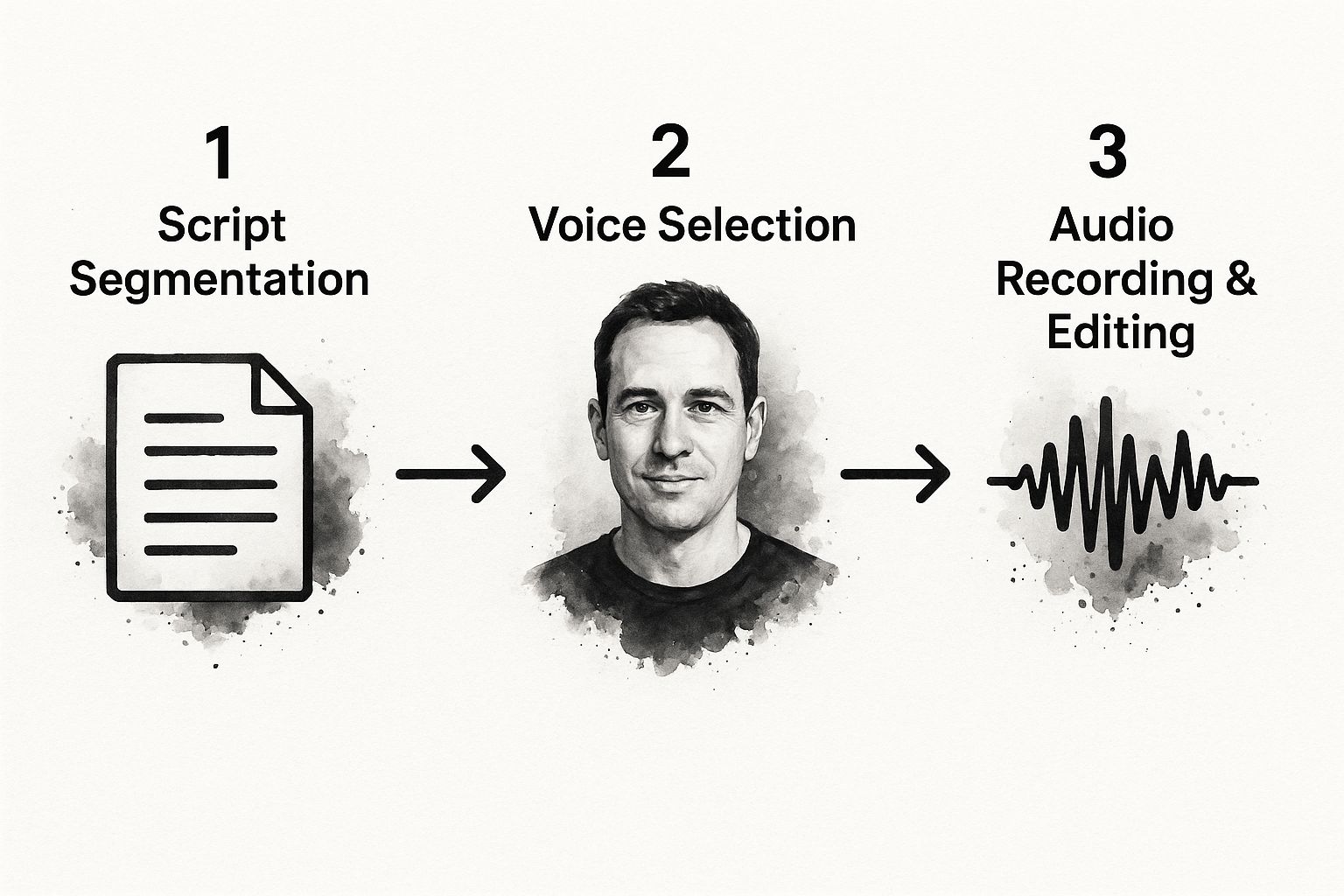Why Turn Articles Into Videos: The Strategic Advantage
Turning your articles into videos isn't just about following the latest trend. It's a strategic move to significantly expand your content's reach and impact. Think of your well-crafted article as a delicious meal. You're currently serving this meal only to a small group who prefer a sit-down dinner. Repurposing that same content into easily digestible video "appetizers" allows you to reach a broader, more diverse audience, much like offering those appetizers at a bustling cocktail party. This expanded reach naturally leads to a more significant impact.
Expanding Reach and Engagement
A key advantage of video is its ability to cater to various learning styles. Some enjoy reading long-form articles, while others prefer visual and auditory learning. Videos offer a dynamic and easily digestible format that can grab the attention of those who might otherwise skim past your written content. Plus, videos are inherently more shareable on social media platforms, potentially increasing your content's visibility and reach, and even going viral.
Boosting Conversions and ROI
Increased visibility isn't just about vanity metrics; it directly affects your bottom line. Websites with video content tend to have higher conversion rates. By 2025, sites with video are projected to have a 4.8% conversion rate, compared to 2.9% for sites without. This shows how video can boost user engagement and drive conversions. To maximize your return on investment (ROI), explore strategies on how to effectively turn blog posts into videos, as detailed in this expert guide. Learn more about the impact of video on conversion rates here.
Extending Content Lifespan and Repurposing Opportunities
Creating videos from articles also extends your content's lifespan. While an article's peak performance might be limited, a video can continue attracting views and engagement for much longer – sometimes even years. This means the initial investment in creating the article continues to deliver value over time. Repurposing your content this way allows you to connect with your audience at multiple touchpoints, reinforcing your message and strengthening brand recognition.

Connecting With Diverse Audience Segments
Different demographics interact with content differently. For example, younger audiences often lean towards video, while older demographics might prefer reading. By providing content in both formats, you effectively cater to a wider audience, maximizing your message's overall impact. This multi-format approach expands your reach and strengthens your brand's position as a valuable resource for a diverse audience.
To further illustrate the differences in performance metrics between text and video content, let's examine the following table:
"Text vs. Video Content Performance Metrics" "Comparison of key performance indicators between text-only and video-enhanced content"
| Performance Metric | Text-Only Content | Video-Enhanced Content | Percentage Difference |
|---|---|---|---|
| Average Session Duration | 2 minutes | 4 minutes | 100% |
| Bounce Rate | 60% | 40% | -33% |
| Conversion Rate | 2% | 5% | 150% |
| Social Media Shares | 50 | 200 | 300% |
As you can see, video content generally outperforms text-based content in key metrics such as session duration, bounce rate, conversions, and social shares. This reinforces the value of incorporating video into your content strategy. By offering both formats, you maximize your reach and cater to diverse audience preferences. Turning articles into videos offers a significant strategic advantage by boosting conversions, amplifying reach, and maximizing the value of your existing content.
Essential Tools To Turn Articles Into Videos That Convert
Turning your articles into engaging videos requires the right tools. Choosing the best fit depends on your technical skills, budget, and desired video style. This section explores both AI-powered solutions and traditional video editing software to help you make informed decisions. Finding the right tool empowers you to efficiently create high-quality videos that connect with your audience.
AI-Powered Video Creation Platforms
AI tools significantly simplify video creation, often requiring minimal video editing experience. These platforms typically analyze your article text and automatically generate visuals, add music, and even incorporate voiceovers. This makes them an excellent option for those new to video creation or seeking a quick and efficient solution.
-
Simplified Interface: Many AI platforms feature user-friendly interfaces, making them accessible to everyone. This lets you focus on your video's creative aspects without getting lost in complex software.
-
Automated Features: AI handles much of the technical work, automatically generating visuals, music, and voiceovers. This saves significant time and effort, especially for complex projects.
-
Rapid Production: Create videos in minutes instead of hours. This increased efficiency allows for more consistent content output, keeping your audience engaged.
-
Scalability: Easily create multiple videos from different articles, perfect for repurposing content on a larger scale.
For example, platforms like InVideo offer features such as converting articles to video, adding AI-generated images and videos, and even editing videos with text prompts. These advanced capabilities let users quickly generate videos from blog URLs, incorporate realistic AI voices in multiple languages, and easily publish across various platforms.

Traditional Video Editing Software
For more advanced editing, traditional software offers greater control and customization. These tools typically require more learning but provide the flexibility to fine-tune every aspect of your video. This makes them ideal for creating polished, professional-looking content.
-
Precision Editing: Fine-tune every detail, from transitions and effects to audio mixing and color grading. This control allows you to craft videos that precisely match your creative vision.
-
Creative Flexibility: Explore advanced editing techniques and experiment with various visual styles. This is essential for creating unique and engaging content.
-
Professional Output: Produce high-quality videos suitable for diverse platforms, from social media to professional presentations. This polished look elevates your brand and builds audience trust.
Choosing the Right Tool for Your Needs
The "right" tool depends on your specific goals. If you prioritize speed and efficiency, an AI-powered solution is a good choice. If maximum creative control is crucial, traditional video editing software might be better. Many creators combine both approaches, using AI for initial production and traditional software for final polishing.
The table below compares key features of both tool types:
To help you make the best choice, we've compiled a comparison of some popular article-to-video tools. This table highlights the strengths and weaknesses of each option, allowing you to see which best fits your needs.
Article-to-Video Conversion Tools Comparison Detailed comparison of popular tools for transforming written content into video format
| Tool Name | Best For | Key Features | Price Range | Ease of Use | Output Quality |
|---|---|---|---|---|---|
| InVideo | Quick video creation from articles | AI-powered editing, text-to-video, templates | Varies based on subscription | High | Good |
| Pictory AI | Creating engaging videos from blog posts | Automated video generation, customization options | Varies based on subscription | High | Good |
| Lumen5 | Social media videos | Easy-to-use interface, stock footage library | Varies based on subscription | High | Good |
| Kapwing | Short-form videos | Templates, quick editing tools | Free and paid plans | High | Good |
| Adobe Premiere Pro | Professional video editing | Extensive features, precise control | Subscription-based | Lower | High |
| Final Cut Pro | Mac users, professional editing | Powerful editing tools, optimized for Mac | One-time purchase | Lower | High |
| DaVinci Resolve | Color grading, professional editing | Advanced color correction, editing tools | Free and paid versions | Lower | High |
As you can see, AI-powered platforms generally offer a simpler user experience, while traditional software provides greater control over the final product. Consider your technical skills and the level of customization you require when making your decision.
Ultimately, the best approach is to experiment with different tools and find the workflow that best suits your resources, technical expertise, and content goals. This exploration will help you unlock the full potential of video and transform your articles into captivating visual stories.
Transforming Articles Into Videos: The Proven Process
Turning your compelling articles into engaging videos involves a systematic approach. It's about repurposing your content to reach a wider audience. This section offers a practical, step-by-step guide to create resonant videos from your articles. You might be interested in: How to turn blog posts into video to boost engagement.
From Article to Video Script: Structuring for Visual Storytelling
Start by choosing articles with strong visual potential. Look for content packed with examples, anecdotes, or data that translate well into visuals. Then, adapt your article into a video script. Keep your authentic voice, but adopt a more conversational tone suitable for video. Think of it like adapting a novel into a screenplay: the core narrative stays the same, but the presentation changes.
Visualizing Your Content: Choosing the Right Imagery
Identify the visually appealing parts of your article. These could be key statistics, powerful quotes, or steps within a process. Consider a mix of images, screen recordings, and animations to illustrate your points. These visuals should complement your message, not overpower it. A well-chosen image can be highly effective, but a poor one can confuse your viewers.
Condensing and Clarifying: Adapting Length and Complexity
Condensing long articles into shorter videos is a common challenge. Focus on the core message and trim unnecessary details. Complex topics might need simplification for video. Use analogies and examples to explain these concepts clearly. For example, compare a technical process to something familiar, like making a cup of coffee.
The following infographic shows the key steps in creating audio for your videos: Script Segmentation, Voice Selection, and Audio Recording & Editing.

This process ensures professional audio for your videos. From segmenting the script to selecting a voice and editing the recording, each step improves the final product. To simplify audio creation, consider AI text-to-speech tools.
Bringing Your Script to Life: Audio Recording and Editing
With your script ready, choose a voiceover artist or use text-to-speech software. A clear, engaging voice is essential for keeping viewers' attention. Record the audio at high quality and consistent volume. Then, edit the recording, removing any errors and adding music or sound effects. Like a film's soundtrack, good audio enhances your video’s impact. The growth of video marketing is significant. By 2025, about 90% of businesses are predicted to use video marketing, up from 60% in 2016. This is driven by video's effectiveness in increasing brand awareness (96% of video marketers report this) and generating leads (88% attribute this to video). See more statistics here. This widespread use shows the importance of video in a successful content strategy.
By following this process, you can transform articles into videos that grab attention and deliver your message effectively. This maximizes your content’s reach, connecting with your audience in a dynamic way.
Capturing Attention: Optimizing Your Article-Based Videos
What makes a video truly captivating? The key lies in understanding viewer engagement. This means creating videos that not only inform but also entertain, ensuring your message resonates while holding viewers' attention. Let's explore some practical techniques to make your article-based videos truly shine.
The Hook: Grabbing Attention in the First Few Seconds
The first few seconds of your video are absolutely crucial. Think of it as a hook – it needs to immediately grab the viewer's attention and make them want to keep watching. Start with a compelling question, a surprising statistic, or a visually striking scene. This sets the stage for an engaging experience.
Strategic Pacing and Key Message Placement
Just like a well-written article, your video should have a logical flow. Strategically place key messages throughout to maintain viewer interest. Introduce a new idea, illustrate it with a visual or example, then move on to the next point. This keeps the information digestible and engaging.
Balancing Information and Entertainment
While delivering information is essential, don't forget the entertainment factor. A purely informational video can feel dry. Incorporate humor, storytelling, or visually appealing elements to keep viewers engaged and create a more enjoyable learning experience.

Pattern Interrupts and Visual Cues
Keep viewers engaged with pattern interrupts. These are unexpected changes in pace or style, such as a sudden zoom, a quick transition, or a change in music. Visual cues like arrows, highlighting, or animated text can also emphasize key information and prevent monotony.
Mobile Optimization: Catering to the Modern Viewer
With 70% of YouTube watch time coming from mobile devices, optimizing for smaller screens is paramount. Ensure text is easily readable, visuals are clear, and the pacing is suitable for on-the-go viewing. Viewers retain 95% of a message delivered via video, compared to just 10% through text. Learn more about video engagement here. This emphasizes the importance of mobile optimization.
Narrative Techniques for Enhanced Engagement
Just like articles, videos can use narrative techniques to draw viewers in. Weaving a story, even within a factual piece, makes the content more relatable and memorable. A clear beginning, middle, and end provides structure and a sense of completion.
By applying these techniques, you can transform your articles into compelling videos that resonate with your audience and encourage them to watch until the very end.
Strategic Distribution: Getting Your Videos Seen
Creating compelling videos from your articles is a great accomplishment, but distribution is just as important. A solid distribution strategy is key to maximizing visibility and ensuring your content reaches the right people.
Optimizing for Discovery: Titles, Descriptions, and Thumbnails
Think of a video's title, description, and thumbnail as its first impression. They are often the deciding factor in whether a viewer clicks to watch. A strong title should be concise, engaging, and accurately summarize the video's content. The description provides additional context and includes relevant keywords to improve searchability. An eye-catching thumbnail acts as a visual hook, enticing viewers to learn more. Keeping your video's SEO strategy consistent with your original article ensures a unified content approach.
Cross-Promotion: Creating a Content Ecosystem
Cross-promotion between your written and video content establishes a beneficial connection. Embed the video in your original article and link back to the article from the video description. This drives traffic between both formats, increasing engagement and reach. Share your video on social media, adapting your message to each platform. A short clip might work best on TikTok or Instagram Reels, while a longer version could perform better on YouTube. Check out our guide on How video helps sell stuff and its impact on publishing.
Platform-Specific Strategies: YouTube, Social Media, and Your Website
Each platform requires a tailored approach. YouTube relies heavily on optimized titles, descriptions, tags, and playlists. Social media engagement is driven by captions, relevant hashtags, and community interaction. On your website, embedding videos within related content encourages further exploration. Understanding the nuances of each platform is essential.
Engagement Tactics: Fostering Meaningful Interaction
Engagement goes beyond simple views and shares. Respond to comments, ask questions, and create polls to encourage active participation. This transforms passive viewers into a community.
Posting Schedules and Timing: Reaching Your Audience at the Right Moment
When you post your videos significantly impacts their visibility. Analyze your audience's online habits and identify the best posting times. Scheduling tools can help automate this process.
By implementing these distribution strategies, your videos can achieve their full potential. Connecting with your audience and driving meaningful engagement helps reinforce your brand's message and achieves content marketing goals. Turning articles into videos repurposes valuable content, expanding reach and boosting engagement across diverse audiences.
Measuring Success: Beyond Basic View Counts
Turning articles into videos offers exciting opportunities to connect with your audience in dynamic new ways. But to truly grasp the impact of this strategy, you need to look beyond simple view counts. This section explores how to effectively measure success by establishing meaningful metrics and analyzing performance data.
Defining Key Performance Indicators (KPIs)
Identifying the right Key Performance Indicators (KPIs) is paramount. While view counts offer a basic measure of reach, they don't paint the full picture. Consider these additional KPIs:
-
Watch Time: This metric reveals how long viewers stay engaged with your video. A higher average watch time suggests your content is resonating.
-
Audience Retention: This shows the percentage of viewers still watching at different points in the video. Understanding drop-off points can help pinpoint areas for improvement.
-
Engagement Rate: This measures likes, comments, shares, and clicks, indicating how actively your audience interacts with your content.
-
Click-Through Rate (CTR): If your video includes calls to action, CTR measures how many viewers click through to your website or other intended destination.
-
Conversion Rate: This tracks how many viewers complete a desired action, like signing up for a newsletter or making a purchase, after watching your video.
Setting Realistic Benchmarks
Comparing your video's performance to industry benchmarks offers valuable context. Keep in mind that these benchmarks vary by industry and content type. Research relevant benchmarks for your niche to set realistic goals. For example, a two-minute explainer video will likely have a different average watch time than a ten-minute product demo. You might be interested in: How to master video content strategy to boost engagement and conversions.
Creating Custom Dashboards for Performance Analysis
Custom dashboards are a powerful tool for tracking and comparing performance. Build a dashboard that tracks both your original articles and their video counterparts. This side-by-side comparison offers valuable insights into how different formats perform and helps you identify areas for improvement.
Tracking the Entire Audience Journey
To maximize your video's impact, track the entire audience journey, from the initial view to the final conversion action. This holistic view helps you understand the customer journey and optimize each touchpoint. For example, if viewers consistently drop off at a specific point, you can adjust that section to improve retention.
Refining Your Strategy Based on Data Insights
Leading content teams use performance data to continually refine their article-to-video process. Regularly analyze your metrics, identify patterns, and experiment with different approaches. This iterative approach ensures your strategy evolves and remains effective. For instance, if one video style consistently outperforms others, focus on that format to maximize your ROI.
By focusing on these metrics and techniques, you can move beyond basic view counts and gain a deeper understanding of your video's true performance. This understanding empowers you to optimize your strategy and demonstrate the value of turning your articles into videos. Want to effortlessly transform your articles into engaging videos? Aeon, a video creation platform designed for publishers, offers a scalable solution to convert your text content into dynamic video formats. Learn more about Aeon and how it can enhance your content strategy by visiting https://www.project-aeon.com.